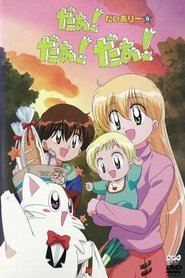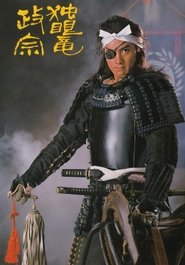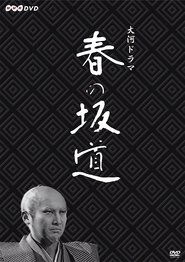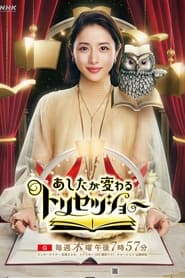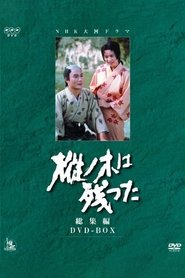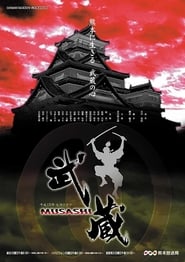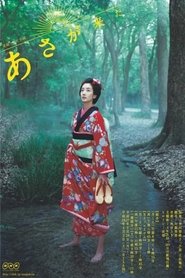Nhk TV Series - Page 3
-
Welcome Home, Mone
2021
star 7.4Born in September of 1995, Momone Nagaura lived with her parents, grandfather, and sister in Kesennuma City, Miyagi Prefecture. After failing her college entrance exams, she went to live in Tome City with an acquaintance of her grandfather's. Momone's life changes when she meets a popular weather forecaster from Tokyo, who teaches her how weather forecasts can predict the future. She decides to study to become a weather forecaster. -
Kashin
1977
Kashin
1977
Centered around Masujiro Omura, who became a commander for the Choshu clan, and founded the modern Japanese millitary system. -
Phi Brain: Puzzle of God
2011
star 7.3Phi Brain: Puzzle of God is a 2011 Japanese anime television series produced by Sunrise. The first two series aired on NHK Educational TV between October 2011 and September 2012, with a third season to begin airing in October 2013. The series is directed by Junichi Sato with script supervision by Mayori Sekijima. Hajime Yatate, the collective penname for the creative staff at Sunrise, is credited with the original story. The anime has been licensed in North America by Sentai Filmworks. A manga adaptation by Yoshiki Togawa began serialization in Kadokawa Shoten's Newtype Ace magazine from November 2011. A PlayStation Portable video game by Arc System Works was released on May 31, 2012. -
Daa! Daa! Daa! UFO Baby
2000
star 8.4Daa! Daa! Daa! UFO Baby is a Japanese children's animated television series produced by J.C.Staff, Directed by Hiroaki Sakurai, and was aired on NHK-BS2 from March 28, 2000 to February 26, 2002. -
Masamune Shogun
1987
star 9.2Broadcast TV drama NHK broadcast on January 4 to December 13, 1987 (Showa 62). In the questionnaire survey conducted by NHK, it is shining in the most favorite river drama. The original is Yamaka Sosaichi's novel "Date Masamune", the biggest drama on the theme of the Date house was the first time in 17 years since the "Shinnogi remained" (1970), which painted Datejo in the Edo period. It depicts the life of Matsudo Date of Sengoku warrior · Date Masamune who built the foundation of Sendai clan 620,000 stones in his generation as a result of my own wisdom and talent. -
Genroku Taiheiki
1975
Genroku Taiheiki
1975
-
Toshiie and Matsu
2002
star 8The 41st NHK Taiga Drama is Toshiie to Matsu. During the turbulent Warring States Era, one man's life and career intertwined with the three great generals of Japanese history-Nobunaga, Hideyoshi, and Ieyasu. With political savvy and the support of his fiercely loyal wife, Maeda Toshiie rose to second in power in the shogunate and built up a fiefdom that encompassed Echizen, Noto and Kaga. -
Ochoyan
2020
star 6.3In the end of Meiji era, Takei Chiyo was born in a poor family in Osaka, and was sent to a theatre tea room as a servant when she was 9 years old. There, she was attracted by the world of theatre comedy. She grows up to be an actor and marries to Amami Ippei , but the war broke out and she was forced to stay away from acting for a while. However, when she comes back again, her acting in a radio drama impresses many people and makes herself one of the leading actors in western Japan. -
Tokugawa Yoshinobu
1998
Tokugawa Yoshinobu
1998
The 37th NHK Taiga Drama is Tokugawa Yoshinobu. The series focuses on the life of Tokugawa Yoshinobu, the 15th and final ruler of the Tokugawa period. Born the seventh son of Lord Nariaki of Mito, Yoshinobu is named shogun when he is just 29 years old. With a wisdom and vision beyond his years, he tries to prolong the life of this 200-year-old dynasty which began with Ieyasu. However, he is unable to forestall the winds of revolution as clans in Choshu, Satsuma and Tosa, with the help of the Imperial Court, clamor for change. -
Haru no Sakamichi
1971
-
Junjo Kirari
2006
star 8The 74th NHK Asadora Drama is Junjo Kirari, which means something along the lines of "pure-hearted Kirari." The story is set in Okazaki City, Aichi Prefecture in the era around the Second World War. When the story opens in 1928, the heroine, Sakurako, is a very active seven-year-old girl. Indeed, even in the first episode she exhibits her confidence and enthusiasm. But above all else, Sakurako is interested in becoming a jazz pianist, and music features extensively in the plot. -
あしたが変わるトリセツショー
2022
あしたが変わるトリセツショー
2022
-
ClassicaLoid
2016
star 7.7In a rural town undergoing revival through music, high school students Kanae and Sousuke meet none other than Beethoven and Mozart! Calling themselves "ClassicaLoids," this mysterious duo creates a strange power through the "music" they play. One night, stars fall from the sky and gigantic robots appear, causing trouble every single day! Bach, Chopin, Schubert also appear as ClassicaLoids. What is the mystery behind the powers they possess? Are they humanity's friend or foe? -
Mominoki wa Nokotta
1970
Mominoki wa Nokotta
1970
Depicting Date clan’s internal strife that occurred during a peaceful Edo period governed by the 4th Tokugawa shogun. -
Kaze no Haruka
2005
Kaze no Haruka
2005
At the age of nine, Haruka moves from Osaka to Yufuin with her father Yosuke and her younger sister Asuka because Yosuke hopes to open a restaurant in the town. Her mother Yuko, however, chooses to stay in Osaka and the parents soon get a divorce. Yosuke starts running a restaurant but ends up closing it down soon after. Ten years later, Haruka supports her family by working part time while going to a junior college. Worrying about Haruka, Yuko invites her to come to Osaka and offers her a job. Although she has not forgiven her mother, Haruka decides to earn money in Osaka to help Yosuke reopen the restaurant. Through various experiences in Osaka, Haruka gradually understands her mother and grows as a tour planner with her talent for pleasing people. -
Musashi
2003
star 8.3Orphaned when he was not yet ten, Musashi grows up skilled in the martial arts. During the Battle of Sekigahara, he fights on the side of the losing Toyotomi forces, but eludes the enemy as they hunt down the vanquished soldiers. He then spends years wandering the countryside mastering the sword. As his fame spreads throughout the nation, men seek him out to test their skills against him--most notably Sasaki Kojiro who faces Musashi in the ultimate duel at Ganryujima. -
Asa ga Kita
2015
star 8Towards the end of the Edo era, in the town of Kyoto, there lived a wealthy merchant by the name of Imai Tadamasa. He was blessed with 3 children, Hatsu, Asa and Kyutaro. His eldest, Hatsu, was a traditional girl who loved to play the koto and sew. Whilst his second daughter, Asa, was an impish hoyden who loved sumo wrestling. Asa was engaged to be married to the second son of a distinguished family who ran a money changer business in Osaka, Shirooka Shinjiro. Although Asa was furious when she had first heard about the betrothal, when she met up with Shinjiro for the first time, his charisma greatly attracted her and she fell in love with him in no time. -
Dear Radiance
2024
star 9Murasaki Shikibu (Yoshitaka Yuriko), the heroine of this story, wrote the bestseller 'The Tale of Genji,' transcending a thousand years during the Heian period. She weaves the story of Hikaru Genji, fueled by her love for Fujiwara no Michinaga (Emoto Tasuku), with her hidden passion and incomparable imagination. It is a tale of a woman who lived with unchanging love in an ever-changing world. (From TV JAPAN) -
かいじゅうステップ ワンダバダ
2019
かいじゅうステップ ワンダバダ
2019



